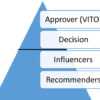Ed Finn is a Regional Sales Manager at Silver Peak, an SD-WAN technology company that was just acquired by HPE.
“When Irish eyes are smiling. . .” I’ve heard that song both at home and in the pubs for years. At home my mom would sing it but in the pubs, lyrics were often different sometimes and a little raunchier. Needless to say the message was clear in both cases as you could tell somebody’s smiling just by their eyes. The lyrics of the song are never more poignant than now as the majority of the population is walking around with their mouth and nose covered. This presents an interesting dilemma for salespeople, who make their living from their ability to be able to read people. Based on their facial expressions, you can adjust to their demeanor and even address conflicts in order to solve issues and meet the goals of both the company and client.
I’ve heard throughout my years as a sales professional the debate as to whether sales is an art or a science. I would say that if you ask any sales professional most will say that it’s both. On the science side the researchers Haggard and Issacs in 1966 discovered what would later be called “micro expressions.” The website Science of People identify micro expressions happening as fast as 1/15 or 1/25 of a second and fall into 7 categories: disgust, anger, fear, sadness, happiness, surprise, and contempt. Sales professionals can interpret these expressions consciously and mostly unconsciously by reading, interrupting, adapting, and laboring to change these expressions to happiness.It’s a combination of both art and science but how do you read their expressions when there is a mask covering half the face!
So, let’s consider that eyes do smile, but they also frown, cringe, grow wide with fear or surprise, narrow with contempt or anger. As sales professionals, we are keen enough to tell the difference without the benefit of the whole face. Is this something we even think about or consider? Negotiating a sale often requires having an understanding that the person you are negotiating with is telling you the truth, part of the truth, or not at all.
The fact is Sales professionals don’t often take the time to truly analyze what we do, because we are usually too busy doing it. But what stands to reason is that if we can read the expressions of others, there are those who can certainly read our expressions. The most successful salespeople I have ever met or worked with are as honest as they come. The truth is the truth it doesn’t change, and the best sales professionals know how either consciously or subconsciously to present that. The truth does not change, but how it is presented does and this is where the experienced sales professional shines. These micro expressions and being able to read and understand those you are presenting to and adapting the presentation to that feedback is where the science feeds back into art.
Back to the original question – do eyes smile? My Irish grandfather would tell you of course they do, and he may even sing you a song to prove it, but the fact is science backs him up. Masks will certainly put this to the test as the world begins to open and interactions begin, albeit covered. Assessing whether those Irish eyes are smiling will mean more than ever.
The inherent skills of salespeople include reading people by their voices, eye movements, hand gestures, and other body language you pick up when in the same room with them. This is also known as your “gut feeling.”
I don’t mean to sound devious, and it is certainly not perfect, but these skills are used daily but rarely studied rarely. That is not to say there isn’t a huge market of how to books and websites devoted to learning micro expressions, mirroring, and motivational interviewing techniques. It is all out there









